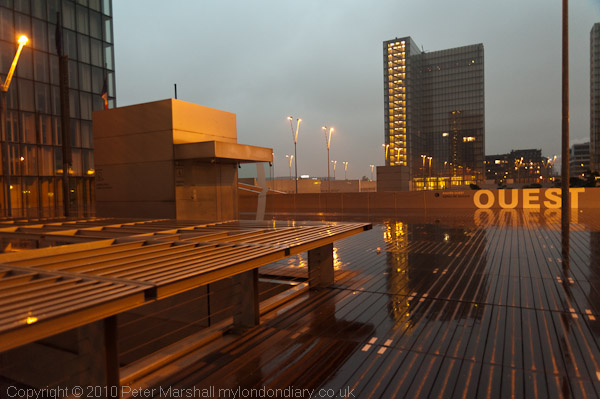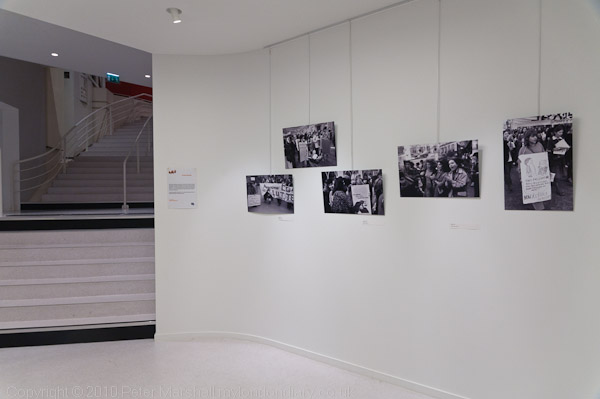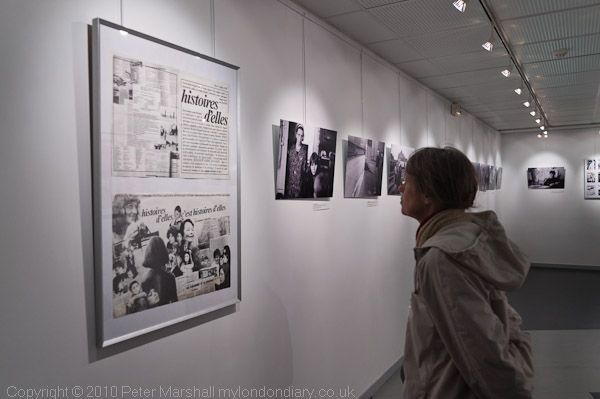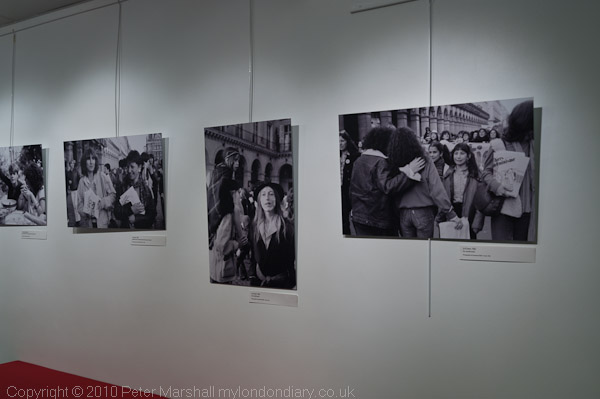
Bibliothèque nationale de France
Later on Sunday afternoon we went on to the Bibliothèque nationale de France (BnF), and spent some time wandering around on the top of this rather ridiculous building trying to find a way in. Even though we’ve been there quite a few times, it still isn’t obvious particularly when you arrive there from a new direction as we did.
The main show there was Raymond Depardon’s France, and there were longish queues waiting to see it. Fortunately I’d decided I’d seen enough of the Depardon work already, and was probably also familiar with much of the other material, so felt no need to pay and join them. What I was interested in was France 14, curated by Depardon and previously shown at the 2010 Rencontres Internationnal in Arles , with work by 14 youngish photographers (I think all in their 30s and 40s.)
Having gone through the scanner and having being allowed in to the entrance hall, we looked around for any signs of where this could be and could find none, so I got my ‘interpreter’ to enquire of one of the apparently unemployed uniformed men, but he had no idea either.
We wandered down the corridor past the queue for Depardon and found it was on the walls there, each photographer having a large area of wall to themselves with a numbered board with some information about them and their project. You can read more about the show (in French) and see some pictures in the BnF press release, and there is one picture by each photographer in a slide show on Liberation, but otherwise little on the web about the show, although there is also a book.
The 14 photographers, Jean Christophe Béchet, Philippe Chancel, Julien Chapsal, Cyrus Cornut, Gilles Coulon, Olivier Culmann, Raphaël Dallaporta, Franck Gérard, Laurent Gueneau, Olivier Jobard, Stéphane Lagoutte, Gilles Leimdorfer, Malik Nejmi and Marion Poussier, decided in 2006 to work as an informal group on the project, with each working in their own way on an aspect of the social and geographical representation of French cities and housing estates.
The resulting work was extremely varied, and some of the responses I found much more interesting than others. The Parisian facades by Gilles Leimdorfer, highly detailed and all taken from a direct frontal view, did, despite the text seem to concentrate on the decorative – for example the offices of La France with their sculptural decoraton of the fading advertisements above a Muslim butchers and other shops. While I found the images – like the actuality – fascinating, perhaps the approach was just a little too programmatic for my taste when viewing the whole set of work.
I was disappointed that there were only 3 pictures in Laurent Gueneau‘s ‘Dominante verte‘ but his web site is worth looking at, with a wealth of other images. Another photographer whose work interested me was Julien Chapsal, and the 15 pictures in his (Où) Suis-je? – (where) am I? – is very much an investigation of the idea of place (or non-place) in modern suburbia. You can see for yourself in the images and text on his web site.
Something very different but also enjoyable were the 18 images of Voyage en périphérie by Cyrus Cornut, images from the new suburbs of the banlieue around Paris. These pictures have an unreal drama, which perhaps matches their typically French architectural flamboyance, although the prints on show at the BnF were slightly less over the top in saturation than those on the web site. Most are seen across sports pictures or with a single sihouetted figure in the background, often at night or dusk.
Perhaps the most intriguing set of work was by Olivier Jobard, who had been sent to Chanteloup-les-Vignes as his first assignment as a young ‘intern’ with the French agency SIPA. A development programme had changed this over a few years from a village of 2,500 people on the Paris outskirts to a small industrial new town with a population of 10,000, including many new immigrants to France, and he was sent to make his report there after an eruption of urban revolt. He states that his work at the time was limited to the habitual clichés of the banlieue – a sick generation, drugs, ghettoism, violence…
Now well known as a photojournalist, particularly for his work in Sudan, he returned to Chanteloup, photographing there again and letting some of the residents tell some of their own stories with his images in ‘Chanteloup. Récits de banlieue‘.
What I did not realise from the BnP show was that he returned there to make a documentary film for the TV channel France 5, along with Fanny Tondre, who was responsible for the video sequences, interviews and text in the programme, which includes many more of Jobard’s still images as freeze frames. It has seven sections; a short introduction is followed be 5 sections, one for each of the people who tell their stories in the project, followed by a brief conclusion. It is worth watching on-line, even if you don’t understand French, with the video sections providing some useful context for a number of fine still images.
The film is a considerably more interesting presentation that looking at the images on the wall at the BnF, not least because it uses so much more of Jobard’s work and the words of the people in his piece – as well as some sensitive filming and commentary by Tondre. What we see on the exhibition wall is little more than a static trailer.
40 Years of Women’s Lib
Finally, before finding (rather by chance) a decent cheap restaurant where we had eaten at on a previous visit just off the rue Mouffetard, we took in another show a short Metro ride and walk away, at FIAP Jean Monnet in the 14e, celebrating 40 years of women’s liberation.

Armand Borlant at FIAP
Many of the pictures were views of some of the more significant demonstrations in France by women or about women’s issues (there is a chronology of the movement in French here, and a few pictures here, and a more general survey, also in French, here. Google Translate may help.) Although many of the pictures were taken by women, the group that I found the most interesting were by Armand Borlant, who after working as an engineer in the aircraft industry became the photographer for the magazine Libération, and was later represented by Gamma and was one of the founders of Agence VU.

Histoires d’Elles at FIAP
Also on show was some more outstanding work from Dominique Doan, photographer for the pioneering feminist publication Histoires d’Elles. I’m sorry I can’t find more of her work on the web.

Dominique Doan at FIAP
After our meal, we took the Metro again to Montmartre before going back to the hotel for our last night in Paris. More pictures from our journeys around Paris and from there on My London Diary.
UPDATE:
PARIS PHOTO SUPPLEMENT is now on MY LONDON DIARY
- Wednesday
- Thur am: 9e, 2e & Paris Photo
- In the 3eme
- Brian Griffin – The Black Country
- Jim & Millie’s Party
- Wandering in the 20e
- Lab East at Paris Photo
- To Saint-Germain-des-Prés
- Montmartre at Night
- Street Photography in the 10e
- Guided tour of the Photo-OFF
- Dinner at Chartier
- The Marais
- BnF and FIAP
- Monday Wandering
[…] 4e, before making our way across the Seine to the Bibliothèque nationale de France (BnF), to view France 14, the work of 14 younger photographers selected by Raymond Depardon, and then another Metro ride to […]